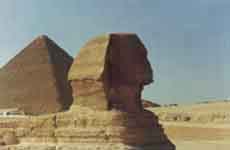Cairo, Egypt

Cairo is the capital of Egypt and the
largest city in the Middle East. Although Cairo itself is only about 1,000
years old, parts of the metropolis date back to the time of the Pharaohs.
The Sphinx and the pyramids of Giza, for example, are visible evidence
of the Ancient Egyptian civilization around the Nile River. The first Muslim
settlement of Egypt was Al-Fustat, now a part of old Cairo. In later years,
Cairo was conquered and controlled by a host of invaders including the
Mamluks, the Turks, and Napoleon Bonaparte of France.
In the 19th century, one of the city's
rulers, Khedive Ismail (1863-1879), sought to transform Cairo into a European-
style city. This, along with the British occupation of Cairo in 1891, led
to the development of new suburbs for the affluent Egyptians and foreigners.
The old city was neglected and has gradually fallen into disrepair. By
the turn of the century, most commercial activity was also moving in to
modern Cairo.

Although the conservation of agricultural
land has long been a priority of Egyptian development policy, much of the
critically needed arable land in Cairo is being lost to urban development;
half of which consists of illegal development and the remainder is planned
new developments in the desert. Although a housing crisis has been broadcast
by the international news media, it is estimated that Cairo may have a
surplus of some 1 million housing units.
Surface waters from the Nile River
are the major source of bulk water supply in Cairo. However, its distribution
system is inadequate. One of the largest sewerage projects in the world
vastly improved the hydraulic capacity of the wastewater system of Cairo,
and has nearly eliminated the problem of sewerage flooding. However, the
lowest income groups in informal settlements on the periphery remain unserved
by existing water and waste-water systems.
Cairo has a serious air pollution
situation due to motor vehicles and industry. The city government frequently
monitors air pollution to measure concentration of noxious gases. In addition,
it utilizes all forms of media to promote environmental conservation within
the city, including celebrations like the annual Nile Inundation to encourage
environmental awareness.
Cairo is one of the world's most
densely populated cities, with one of the lowest provisions of road space
per capita and dramatic growth in the number of private vehicles. Government
actions have only exacerbated this situation by spending on bridges and
flyovers, and heavily subsidizing fuel, all of which promote the use of
private automobiles.
According to a United Nations 1994
estimate, the Cairo urban agglomeration remains home to 9.6 million people
and the figure is projected to reach 13.2 million by the year 2010.
Home | Rus

